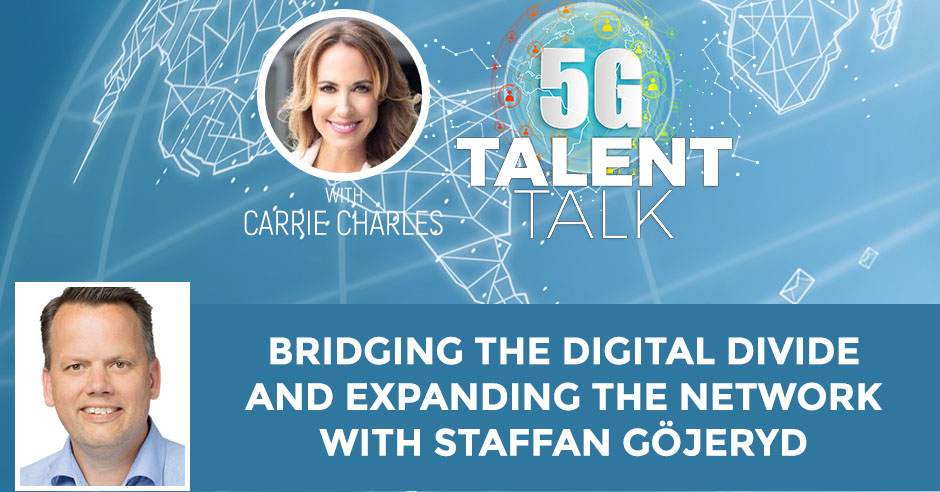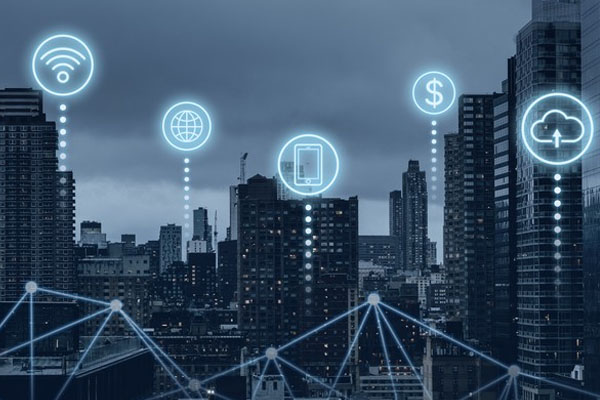
Among other lessons, this pandemic has made us realize the need to bridge the existing digital divide that holds back a lot of people. Expanding the network is a lot of work, but it holds a lot of promise for the future of work, business, and even personal life. In this episode, Carrie Charles talks with Staffan Göjeryd, the CEO of Telia Carrier, who further elaborates on bridging the digital divide and expanding the network. Staffan also shares how the pandemic affected the telecom industry. He also discusses empowerment, learning and identifying that silver lining even during this pandemic.
—
Watch the episode here:
Listen to the podcast here:
Bridging The Digital Divide and Expanding The Network With Staffan Göjeryd
I am thrilled about my guest. I always say this, and I love all my guests, but I’m especially excited because I have Staffan Göjeryd. He is the CEO of Telia Carrier. He is now in Stockholm. Welcome to the show.
Thank you very much. It’s great to be here, Carrie. Thanks for having me.
Tell me more about Telia Carrier, the products, the services, and your network.
No matter who we are, we can make a difference in an organization.
Click To Tweet
I’m thrilled to be able to speak in this show and present a little bit about Telia Carrier. Telia Carrier is a global organization. The services that we’re offering are typically internet services, high bandwidth services between data centers, direct enterprise and voice trading services. Our network is spread out throughout the world. We have a European footprint in North America and also through Asian markets. We have legal entities in 34 different countries and customers in 120 countries around the world. It’s truly a global operation from that perspective.
What makes Telia Carrier different?
We have a few different things. We’re a fantastic blend of people with different nationalities and backgrounds in that case. We’re meeting our clients very locally in many ways, which is highly appreciated by a lot of our partners and clients that we have out there, but also the fact that we’re very centered in connectivity services, which means that everyone is driven around the purpose of providing excellent connectivity services and that sets us apart a little bit. We’re maybe a little bit niche in that context, but it puts a very clear focus on the mind of everyone in the organization to be able to service our clients the best possible way.
How many employees do you have, Staffan?
We have around 500 employees in the organization and spread out in twenty different countries. It’s truly a global spread of the organization as well.
A very important problem that has become more of an issue since the pandemic has been bridging the digital divide. What has Telia Carrier done to work on bridging this digital divide?
First, you have to put us a little bit into the context of what we do and how far out into either rural areas of different countries that we go. We’re typically in around 330 or so different data centers around the globe. What we’re doing is a gradual expansion of the footprint that we have. We’re trying to get further out into new markets and territories where they typically are underserved, in the sense that there aren’t that many options for different types of providers, and ensuring that we can offer great connectivity services in many different places and further out in the geography essentially.
That’s our play of trying to enhance and improve on the digital divide but also making sure that we can provide services to those that are providing services like the one we’re on right now and ensuring that people can communicate well and professionally in a good manner. Whether you’re sitting at home or in your office to be able to work, that’s where we can contribute in making sure that the digital divide is lessened at least and forward in a better way for us.
Do you see that this problem is different in different countries or is it very similar? What are your thoughts?
It is very different between different countries. If I look at the region where I’m from myself in the Northern region of Europe, then that’s a region that is very well connected even in many of the rural areas. When we saw the pandemic hit and people starting to utilize the services from different locations than typically the office locations and things like that, we didn’t see that much traffic growth out of the Nordic region because it’s a very well connected area already.
While you can see definitely in other countries that we’re connecting to that the traffic extensions were quite massive in many different countries and out of different countries, that’s driven very much that there are different pockets or areas even in very well-connected countries that are having issues with good connectivity. If you’re moving further out, maybe mobile connectivity might be a better choice than permanent and fixed services and so forth. It differs a lot almost country by country no matter if you’re in the developing world or the Western world. You can still find poor connectivity and you can find great connectivity in lots of them.

Digital Divide: The pandemic accelerated the demand and the need for public internet and for internet services in general. And that’s a clear trend throughout the global markets as well.
We need help everywhere.
I do believe so. There is still a way to have everyone having extraordinary connectivity no matter where you are or work essentially.
Do you believe that can happen?
That’s what drives me, to be honest. Yes, I believe. Is it going to be quick? Most likely not, but I believe it’s going to happen over time, especially now when you see that people are moving around, sitting, and working in so many different places than what they used to do before. That might be a bit of a driver to accelerate that, but we have ways to go before everyone is extraordinarily well-connected. It will hopefully happen in my lifetime.
Hopefully, you’re going to be a big part of that. It sounds like that’s exciting. The pandemic shattered our worlds, lives, and global economy. How has this pandemic changed the telecom industry and put a magnifying lens on leadership and culture? I know you can’t answer that in a few minutes. That’s a whole book. You’d have to write a book.
It changed the industry in many ways, per se. It clarifies that the telecommunications industry is very important for enabling great connectivity and services so that people can communicate with their loved ones no matter where they are. That’s important for the industry to get a little bit of a rejuvenation almost in the context of the importance. In terms of leadership, customer and employee engagement is very important from my point of view.
What’s driving me a lot, especially in the pandemic era, is that people feel that they’re empowered. If they feel that they’re empowered and can do and make decisions by themselves intuitively almost and know what they’re supposed to take care of and do, that’s a key feature. You’re not having your colleague next to you that you can ask at least not in an easy manner. You have to feel that empowerment on day-to-day decision-making when you are sitting in front of a client or someone to make sure that you can move forward at all points in time. That’s been very important to me that people have information at their fingertips so that they feel empowered from what they know. That also have a cultural backing from the organization where they know that if they make decisions that would also be highly appreciated in the organization and the culture of the organization. Those are important things to me, at least.
Empowerment, what a silver lining? In 2020, we were all sitting in our homes and our worlds, experiencing the effects of the pandemic from our circle. There were global effects on COVID. In your opinion, what impact did COVID-19 have on the global network? Could you give us a bigger view?
What we’ve seen and the whole industry has seen that in many ways it’s a common phenomenon that, first of all, the heartening thing when the pandemic hit, everyone was going back to a little bit of the engineering core of internet and communication, and saying, “Fine. Let’s make sure that this works. Let’s try to ensure that we get enough connectivity between the different networks up and running so that we can ensure that works.”
We saw a tremendous surge and that was not just us at Telia Carrier. Anyone that was providing very global services in that way was almost like a full-year growth in 3 to 4 weeks. It was very rapid, but it worked very well due to the fact that a lot of people were going back to a bit of the engineering core because it’s extraordinarily important that you have your network in order. The internet is global, so you have to have those connectivities working between the different parties on the internet. That was a big effort put in by the whole industry. They made it work, even if it was such a surge in such a short timeframe.
Everyone makes mistakes every once in a while but let's not repeat the mistakes over and over again.
Click To Tweet
It continued growing during the year and we saw maybe about 50% to 55% growth during the full year, which is typically around 30% or so. A lot of effort during the year was to keep up and keep the pace. The industry managed well. I’m very proud of Telia Carrier and the employees managing that situation well both internally and towards our customers. The whole industry did a phenomenal job as well. Everyone afterward had great preparedness and all the fantastic plans, and that’s why it worked. It was a little bit of a collective effort to make sure that it worked throughout that period.
Is there anything that you are doing differently based on what you learned from what you went through in 2020? Anything that changed the goals that you have in the company or the trajectory a little bit?
I would say to some extent that we may have felt that it’s accelerated a bit of the change predominant in the enterprise market and the way is going through now and rethinking a lot of the ways that they’re building their network for the needs of the enterprise and the employees of the enterprise. That has changed a little bit on our strategic trajectory to service that market and segment because it’s not all enterprises at once. That’s a little bit depending on the readiness and where you are in your decision-making, and all of these kinds of things, but at the same time, it’s accelerated quite many different companies that are moving in that direction. That was a change during 2020.
What do you see as a silver lining for leaders from the pandemic?
I don’t know. Is there a silver lining? At least looking at, from my organization and from that point of view, we’ve been maybe very focused on making sure that people are in the office a lot and working there. The silver lining around it, both for the employees and myself, is that we’ve seen this work. The people are very distributed in the organization, maybe you see them working from home for very long periods and people connecting once we’re out of the pandemic. My view is that we should have much more freedom in selecting where you work, if you work from the office or at home, so that you’re able to accommodate different types of employees’ needs, at the different time spans that they have.
At the same time, it’s important to guard the fact that people need to meet, because that’s a cultural barrier in terms of the actual meeting. They have more freedom in choosing where you work from to accommodate different needs that you have in different phases of your life, maybe for a time have more importance to work from home and that hopefully can attract more employees to our organization and quantify the people to our organization as well.
We are finding as a staffing firm that many candidates are asking for remote work or hybrid remote work, and they’re getting it. It is a barrier many times to the companies who don’t allow that freedom and flexibility. I agree with that and do think it is a silver lining. It’s an opportunity for companies to rethink their model and look for the benefits there. You have a unique view of the company culture through the lens of customer experience. Can you talk more about your perspective here?
It goes back a little bit to when I was talking about empowerment. We’ve discussed this a lot internally in the organization of trying to make everyone understand and talk about it in the context of that you meet the customer in so many different phases of their interactions with you. All different parts of the organization are equally important. Sometimes you may focus on customer experience and in the meeting with the sales organization or just in customer care.
It’s equally important throughout the entire chain within the organization that everyone feels that it’s customer first, but also that you feel empowered to deal with a customer in a professional and good manner, where you feel enough empowerment to make your call a little bit in those interactions with the client, no matter where in the process or in the different touchpoints that you’re interacting with the customer. That, to me, is crucial because if you do that in the experience of interacting with Telia Carrier is consistent, no matter which part of the organization you’re interacting with. That’s extraordinarily important so that you don’t feel that it’s a divergent organization interacting in different manners, depending on which part of the organization you’re interacting with.
It is challenging for sure to make sure that everyone is on that level. There are a lot of great books written about good customer life cycles and things like that from a consumer perspective, but then it’s only one individual. When you’re interacting with B2B enterprises, you have many different touchpoints that you have with those organizations. You have to think about how do you meet up with those different functions within the B2B organization in the best possible manner, which is very different. There are a lot of books written about customer experience from an individual consumer basis, but very little well-written on B2B customer experience and how we mitigate those kinds of different views because of so many different people and touchpoints that you interact with.
This is an opportunity for you to write that book, Staffan.
I was thinking you were going to write it. I’m going to try to edit yours instead.
You got. We’ll work it out. You said empowerment a few times, which I love the concept and idea of empowering people. How do you empower people in your organization?
Our organization is 500 people, so it’s not huge. It’s a very flat structure of the organization. It’s pretty close from all different levels of the organization for reachability. Everyone feels that they can reach out as well in different directions. We’re not necessarily extraordinarily hierarchical, so that you have to go up and down the chain all the time. It’s a lot of cross-functional discussions going on, which makes people view things from different angles. If you do that and at the same time, you feel that you have the right to make your individual decisions and that you don’t have to go up and check every time and say, “Fine. Is this the way that I am supposed to act or not?” People become empowered, and they feel that they can make decisions of their own.

Digital Divide: It is very important for employees to actually be a natural part of what the company does rather than being required or enforced to do something.
Everyone makes mistakes every once in a while. I make mistakes. Let’s not repeat the mistakes over and over again. That’s fine. If you do that, then it’s allowed to make a little bit of mistake and that you feel that it’s more important that you progress and make a decision then people feel empowered. That’s very important for people to make it be a natural part of what you do rather than something that you’re trying to enforce or whatever you want to call it.
Something that you said in one of your articles or blogs. The first thing is that this customer experience and your view of it promotes a sense of ownership from everyone in the organization and you’ve described that. The other thing that you said, which I love is I want to live in a world where customer experience is no longer a differentiator but a commodity. That’s good because it’s true.
We hope we get there.
You have a unique view because you work in so many different countries with so many different cultures, operations, trends, and all of that. If you take a look at telecom globally, what trends are you seeing over the next 1 to 3 years?
I can say we now call this 5G talent, so 5G is on everyone’s lips anyway. That’s a key you’re trending in so many ways. We’re in a little bit of a shift when you look at the typical technology side and things like that because we’re going much more from the environments that are a bit more disaggregated from each other so that you’re not necessarily having to buy things in that manner. That’s a clear trend. What we’re also seeing is what’s driving a lot of the development is the massive volumes of connectivity needs that are being serviced in the data center environments.
We see that those components, services, and things that have been there has been moving to the core network footprints, which is a clear driver and trend in the entire telecommunications industry of servicing that in a completely different manner. I’m a firm believer that the pandemic is a silver lining to it in any way whatsoever. It’s accelerated the demand and the need for public internet and internet services in general. That’s a clear trend throughout the global markets as well.
What is on your agenda for 2021? What’s your focus for Telia Carrier?
In the short-term perspective, it is very much in focusing on keep on gradually expanding our network, making sure that we’re putting ourselves in the right position. What we learned from the pandemic is also something that we’re carrying with us into 2021. It’s to the network a little bit more so that we can do expansions much quicker than what we were able to traditionally. That’s something that we’re spending a lot of time and effort on in 2021 to make sure that we can scale our network in a better and more efficient way than what we typically have been able to do before. We’re not doing that for internal purpose. It’s to make sure that we’re readily available to be able to meet those continued demands that we’re seeing and continue expanding our footprint into different data centers, PoP locations, or whatever you call it to be there, but also be able to service for those higher needs that we see coming out of 2020.
Who are your customers globally?
Our customers globally are, if I do it short, the vast majority of those have high bandwidth demands or have moved their parts or entire business model over to the global internet. Those are typically our clients. It’s anything from operators to network service providers, content players, security companies, media companies, and different other types of verticals that have moved their business model and are on their way to moving their business model to the internet.
When people become empowered, they feel that they can really make decisions of their own.
Click To Tweet
Where do you see yourself ten years from now? You’re young and going to be here in ten years. Where are Telia Carrier and we going to be? Where are we going to be as an industry globally?
Going back to a little bit on what you were talking about before within the digital divide in some ways where I would like to see ourselves, is to be pretty much in every market. Ten years is may not be long enough for that. I’m driven by connectivity enablement and making sure that we are in markets with high needs and requirements. That internet is perceived as a business-critical aspect of what you’re doing. My dream would be that Telia Carrier was everywhere.
That’s a good dream. What drives you? I tend to ask this question from leaders many times to find out what is your why? What gets you up in the morning? You face challenges every single day.
I make and we make a difference as an organization. That’s what drives me on a daily basis. It’s exciting. If you go back to that core of what it is that we’re doing and we’re fundamental in world-changing technologies, that the internet is and it’s still, even if it now has a commercialized service of some years depending on how you calculate it on and as a service, but it’s still an infant in some ways. There is so much development and more movement left in how internet and internet services and everything around it is going to be connected. That’s what makes me get up in the morning.
I believe that you’re going to do it in every market and every country all over the world. I have no doubt in my mind. Where would we go to find out more information about Telia Carrier?

Digital Divide: Being a fantastic blend of people, with different nationalities and, and excellent backgrounds are essentials in building a strong organization and expanding the network.
LinkedIn and Twitter are always good, @TeliaCarrier as the handle there, and then www.TeliaCarrier.com as well. These are good sources.
Staffan, this has been wonderful. Thank you so much for coming to the show. I learned a lot. I wish you all the best. Hopefully, we could do it again someday.
Thank you very much. It was nice being here.
You take care.
You, too.
Important Links:
- Telia Carrier
- LinkedIn – Telia Carrier
- @TeliaCarrier – Twitter
About Staffan Göjeryd
 Staffan Göjeryd was appointed CEO of Telia Carrier in August 2016. Having started at Telia Company at a time when a 14k modem was considered high tech, he has since helped drive Telia Carrier to its position as one of the world’s leading global backbones. His focus on customer excellence and delivering exceptional quality to Telia Carrier’s customers are just two of the areas that have taken him on this literal journey from the trenches to high command.
Staffan Göjeryd was appointed CEO of Telia Carrier in August 2016. Having started at Telia Company at a time when a 14k modem was considered high tech, he has since helped drive Telia Carrier to its position as one of the world’s leading global backbones. His focus on customer excellence and delivering exceptional quality to Telia Carrier’s customers are just two of the areas that have taken him on this literal journey from the trenches to high command.
Despite knowing all there is to know about connectivity, Staffan’s main interest is what customers actually do with it. Having seen the repeated cycles of Internet boom and bust, he knows it takes more than belief and adrenaline to build a successful business.
Staffan has held technical and customer-facing roles within Telia Company in both Europe and North America. These include the Director of Network Planning and the head of Telia Carrier´s Data and Infrastructure business. He holds a Bachelor in Business Administration from Linköping University and is an accomplished golfer – a hobby currently taking second place to his kids.
The post Bridging The Digital Divide and Expanding The Network With Staffan Göjeryd appeared first on RCR Wireless News.
